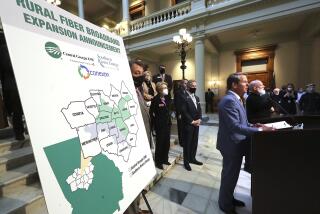Universal Service Must First Serve Community
- Share via
The Telecommunications Reform Act of 1996 left a lot of unanswered questions about the character of the “information superhighway”--chief among them the future of universal service. The Federal Communications Commission, charged with working out the many crucial details of the new law, has been been taking public comments on universal service for the last month, and we’re starting to see some novel ideas about how this concept might change in the next century.
Universal service is a technical term in telecommunications policy, a broad mandate that has been part of U.S. telecom law since the 1930s. It requires telephone companies to provide telephone service “at reasonable cost” to all customers within their service areas at roughly the same rates. That has meant that areas in which it’s expensive to provide service--especially rural areas and low-income communities--pay below-cost rates and are subsidized by above-cost prices for high-volume residential and business customers.
Many experts believe the universal service policy is responsible for the high penetration of telephone service throughout the U.S.--to about 94% of households. That still leaves about 6.5 million Americans without telephones in their homes, however. Updating universal service for the future is a challenge that involves not only bringing “plain old telephone service,” or POTS, to the millions of people still unserved, but also of expanding universal service to new, interactive technologies and services.
If universal service is limited to POTS, policy issues are not very complicated. Everyone, rich or poor, who uses a telephone gets the same thing when her or she picks up the receiver: a dial tone. The telephone is also used, almost exclusively, as a device for communications between two people.
But the Internet introduces a lot of complications. If we move toward a universal digital information network, what will people get when they turn on the “information appliance” of the future? And how do we marry universal service with a network that allows “one to many” and “many to one” communication? Should switched, broad-band video be part of basic service? Or should we aim for universal e-mail, as a recent report from the Rand Corp. suggests?
The Telecommunications Reform Act includes a restated commitment to universal service in the U.S., and it directs the FCC to establish periodically updated guidelines, “taking into account advances in telecommunications and information technologies and services.”
*
The act sets up a federal Universal Service Fund, to which telecommunications companies will contribute--although exactly who will contribute how much is a subject of heated debate. These funds are to be used to pay for the goals of universal service policy, which include “access to advanced telecommunications and information services in all regions of the nation” and “services and rates in rural, insular and high-cost areas that are reasonably comparable to those in urban areas.” (There are separate provisions for schools, libraries and health-care providers.) Although these goals are admirable, the problem with this approach in a new era of computer network communication is that it is based on the telephone model of “access.” When the principal communication device is the telephone, universal service simply means having affordable access to the telephone network.
But it is not yet clear what basic service will mean on the Internet. And that is of most concern to low-income people, because they’re the ones who will be most reluctant to pay for anything beyond basic service. Moreover, until network access devices get as cheap and as easy to use as telephones--which may be a very long way into the future--we can expect that large numbers of poor people will not be able to find the money required to use the Internet, even with subsidized access.
The telephone model of access is oriented to individual consumers. But increasingly we’re finding that the solution to getting network access and skills into low-income communities is community-based. If poor people can’t afford personal computers, modems and network accounts in their homes, they can go to community centers, bus stops, laundries, restaurants, “cybercafes” and other neighborhood “hangouts” to get access to the Internet. Poor people often don’t own telephones or cars, but they can use pay phones and public transit. What we don’t have yet is the Internet’s analog to pay phones or public transit.
This is what a new, community-based perspective on universal service could provide. Instead of perpetuating the individualist, consumer-oriented approach retained from the telephone era, a universal service fund aimed at supporting community access and content could help solve the problem of what basic service will look like on interactive networks.
For example, the universal service fund could help support not just equalized rates, but also community resources such as information on day-care, local government and health education.
A community-based approach to universal service should not completely supersede the goal of serving individual households equitably. But by adding this new dimension to universal service policy, we could enrich the Internet and the lives of millions of citizens in the United States.
Gary Chapman is director of the 21st Century Project at the University of Texas at Austin. His e-mail address is gary.chapman@mail.utexas.edu





